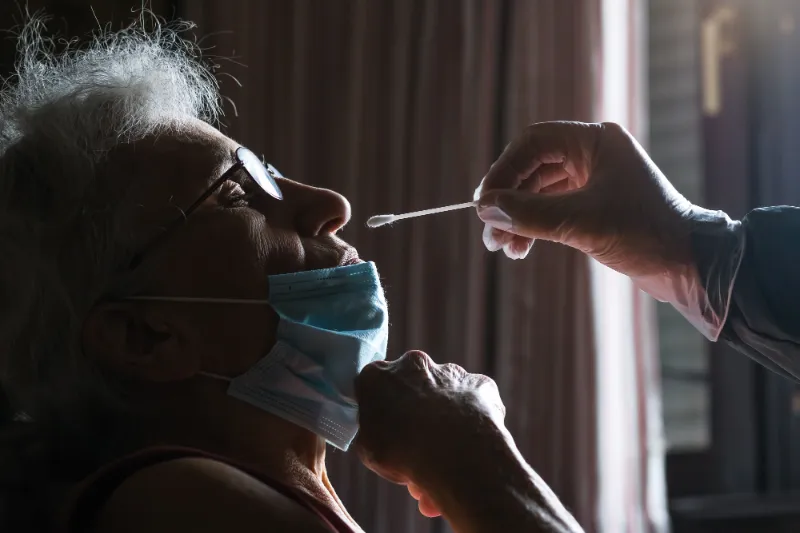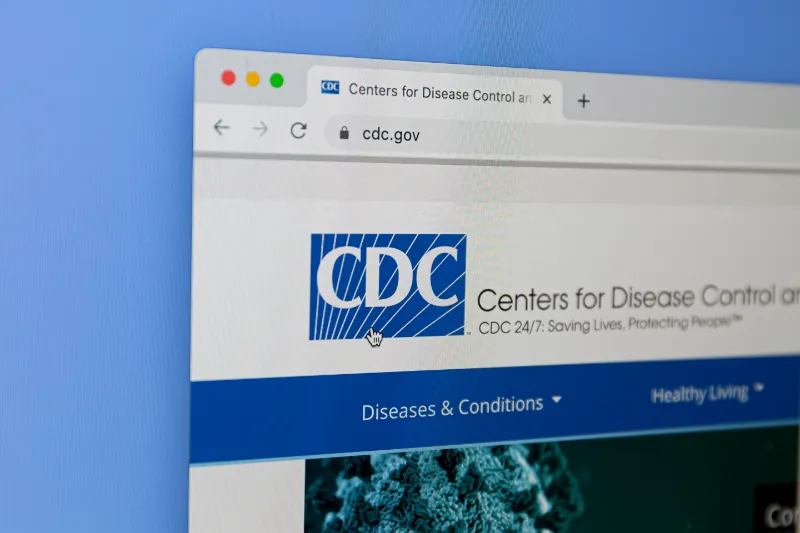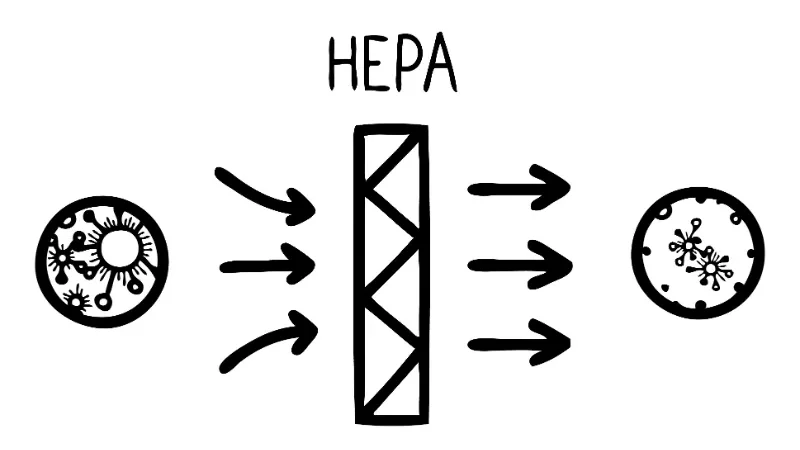Nursing homes are ground zero for airborne outbreaks like Covid-19.
A staggering 90% of all COVID-19 deaths this year have been older adults. Even if you wear masks and keep your distance, viruses can still get through fabric and stay around for a while.
Protecting our elderly starts with clean indoor air. Specialized air sterilization is the new standard of care. This comprehensive guide will explore COVID risks, prevention methods, and air quality technology. Let’s learn how to protect vulnerable residents from COVID in nursing homes.

Nursing homes have unique challenges that make diseases like COVID-19 spread fast. Let’s delve deeper into the factors that make these environments particularly susceptible.
Loved ones, staff, healthcare workers, and more enter and exit nursing homes daily. One infected person can spread a new virus in nursing homes with lots of traffic.
SARS-CoV-2 and other viruses stick to clothes and hair. They can stay in the air for a while after someone leaves.
Even brief interactions or deliveries allow viral particles to infiltrate. Without proper air precautions, these particles build up and recirculate indoors.
Most nursing home residents are elderly with several comorbidities. Their immune systems are often not ready or strong enough to fight viruses and illnesses.
When older people breathe in a virus, they are much more likely to get infected than young, healthy people. Their weakened immune systems are unable to defeat the infection and become overwhelmed. It dramatically raises the risks of severe complications or death!
Small, confined indoor spaces allow airborne particles to spread far faster than outdoor settings. Nursing homes have compact rooms and shared common areas.
Central HVAC systems recirculate air throughout the entire facility. This spreads any airborne contaminants. Without proper air purification methods, viral particles accumulate fast as air recirculates.
Residents inhale high viral loads from this recirculated air. Their already compromised immune systems become overwhelmed.
In February 2020, a big COVID-19 outbreak occurred at the Life Care Center nursing home in Kirkland, Washington.
The virus spread fast. It infected two-thirds of the nursing home’s residents and staff. In the end, it caused the deaths of over 35 residents in only a few weeks.
The virus spread quickly among the residents of the facility. Visitors and staff introduced it without realizing it.
The building’s air filters were not good enough, so the virus spread through the vents. Before long, the virus had infiltrated every floor of the facility.
The Kirkland outbreak showed how viruses can spread in nursing homes. These places need to improve air quality measures and take precautions immediately. The sad events at Kirkland remind us how serious airborne illnesses can be.
Starting in 2020, the CDC made strict rules to stop COVID-19 from spreading in care homes. CDC long-term care COVID guidelines are helpful but don’t eliminate risks.

Facilities should check their temperature when visitors come and ask about symptoms or exposures. But many infected people are asymptomatic. Reliance on symptom screenings misses 50% or more potential contagious visitors.
Frequent PCR testing helps identify even asymptomatic staff. But test results take 2-4 days to return. The nursing team exposes residents while awaiting test results without realizing it.
Plus, no test is 100% accurate. False negatives miss infections while giving the staff a false sense of security. Testing reduces but does not stop transmission risks.
The CDC guidelines for nursing homes say that staff should wear PPE, like masks. Fabric masks only filter 60-80% of viral particles. Surgical masks are better, blocking 95% of particles.
But gaps around the sides still allowed viruses to escape, especially when talking or bending over. Neither mask type forms an airtight seal. Residents can’t wear masks when they eat, sleep, or have respiratory treatments, further complicating the situation.
Admitting new residents from external hospitals requires a 14-day observation period. After 14 days, the germs from the new resident have likely spread through the ventilation ducts. Quarantine protocols help but come too late to contain exposures in their entirety.
Nursing homes are not legally allowed to deny visitors. But they can limit or restrict visitation in certain situations, such as during a pandemic.
Nursing homes have the right to require all staff and visitors to be vaccinated against COVID-19. This helps protect vulnerable residents from potential exposure and outbreaks within the facility.
Nursing homes often face misunderstandings about the best air cleaning choices to consider. Let’s dispel a few common myths.
While letting in some fresh outdoor air can help, it is far from enough. Outdoor air still contains pollutants and allergens that can worsen respiratory conditions.
Open windows don’t impact recirculated air from HVAC systems. Most people open them only on nice days.
The HVAC system still spreads contaminants throughout a building on cold and rainy days. Uncontrolled airflows from open windows can also disrupt HVAC pressurization and ventilation balance.
Opening windows can add to a purification system but they can’t replace purpose-built solutions.
Portable fans recirculate, rather than purify, existing air. If not sealed with high-quality HEPA filters, these let viral particles spread through the air.
Small portable units only filter minimal air in immediately surrounding spaces. Their limited power and size restrict their effective range. They don’t impact facility air flows, especially in HVAC systems.
Portable units might reduce nearby exposure by recirculating filtered air, but only to some extent. They can’t match centralized HVAC purification systems’ treatment capacity or whole-facility protection.
Masks help but don’t negate the need for complete air treatment. Cloth masks filter only 60-80% of virus particles due to gaps and porous material.
Staff members may reuse masks for days, allowing pathogens to accumulate on the mask surface. Residents cannot always wear masks when eating, sleeping, or receiving care. Masks don’t affect recirculated air moving through ventilation systems.
Masks are essential, but air purification is needed to reduce the spread of viruses. Together, masks and air purification provide layered protection.
Clean indoor air stops viruses before they reach and infect residents. Specialized air sterilization technologies destroy viruses, providing constant protection between tests and exposures.

Standard HVAC filters remove large particles like dust. The tiny size of viral particles allows them to pass through filters.
HEPA filters can capture some viruses but become saturated. Viruses then bypass the filter and recirculate indoors. Passive filtration alone is unreliable.
Better filters help but are not enough. Active sterilization methods destroy biological contaminants. They purify the air by using UV light, ion generators, oxidizing agents, or non-thermal plasma systems.
These advanced systems don’t only trap viruses. They inactivate them to prevent airborne transmission. This standard of technology is essential for vulnerable populations.
Portable room air cleaners only filter small spaces. Whole facility protection requires central air sterilization systems that treat continued full-volume airflow.
It prevents the entire air supply from becoming a transmission pathway. It provides constant sterile air whenever residents are present.
The less viruses present in the air, the lower the risk of transmission and severe illness. Like washing hands, air sterilization reduces total viral load to cut exposure risk. Even if the virus spreads, having less of it makes the infection and problems less severe.
No system is perfect, but a multi-layered strategy provides the best security. Air sterilization offers an extra layer of protection.
It’s helpful to have when there are false negatives in weekly staff tests or potential exposures from visitors. And it complements existing protocols like screening, PPE, and testing to reduce gaps.
Heating, ventilation, and air conditioning (HVAC) systems are crucial in nursing home air quality. But these complex systems can also enable the spread of illness if not controlled.
HVAC systems come in two main configurations:
Air is filtered, heated, or cooled in nursing homes in one central location. Then, it circulates through ducts to different areas.
Centralized systems have powerful air filters and purifiers to treat all recirculated air. The downside is that any disruption or contamination spreads.
Some long-term care facilities use decentralized, point-of-use HVAC systems. These have compact air handlers in each room.
Point-of-use systems localize filtration and present less risk of facility-wide spread. But there is more maintenance, and air in common areas remains untreated. Regardless of system type, several factors impact how well HVACs filter and purify indoor air:
Air always follows the path of least resistance. Any small openings or leaks in the HVAC system allow air to bypass filters.
Seal all doors, ceilings, duct joints, and vents to optimize airflow through the filtration system. Facilities should inspect for gaps around air handlers and other bypasses. You may need professional duct sealing in some cases.
The minimum filtration standard for most HVACs is a MERV-8 pleated filter. While these remove dust and debris, tiny viral particles pass through. Upgrading to a MERV-13 pleated or bag filter improves virus capture.
But even MERV-13 filters only stop around 50% of coronavirus-sized particles. HEPA filtration or active air sterilization methods are needed for optimal virus removal.
Bringing in more outdoor air can help dilute and flush viral load. The CDC recommends maximizing ventilation rates whenever possible.
But outdoor air still contains pollen and pollution. Better ventilation rates put more strain on HVAC systems as well. To improve indoor air quality, you must find a way to add fresh air without removing filtered indoor air.
Routine duct cleaning removes dust buildup and improves airflow. It’s easy for ducts to become contaminated all over again after cleaning. The benefits are temporary.
Understanding a facility’s HVAC system is critical to identifying any vulnerabilities in airflow patterns. Nursing homes should consult HVAC experts to assess their unique situation and determine the ideal air quality solutions.
A specialized air sterilization system is an essential addition to nursing facilities. But many technologies exist to clean or purify air, each with pros and cons. Important factors for long-term care facilities to consider include:
The system must inactivate known viral threats like coronaviruses under real-world conditions. Lab testing must verify a high inactivation percentage of 99.9% or more. The technology must be validated by independent tests for unbiased results, not only by internal company data.
The system must treat the full-volume airflow throughout the facility’s HVAC system. It ensures no air goes untreated, reducing the viral load everywhere residents are present. Units that only purify room-level air cannot provide whole facility protection.
The system should not have harmful chemicals that could hurt vulnerable residents. It should avoid excessive ozone emissions, which can exacerbate respiratory issues. The cure cannot be worse than the disease.
You must balance real-world maintenance, energy use, and installation expenses with treatment effectiveness. Make sure the system is easy for staff to operate. Verify accessible replacement parts and filters to maximize uptime.
Look for equipment with a track record of performance in healthcare settings. Seek systems with minimal reported downtime for repairs and cleaning. And select technology that will remain effective even as viruses evolve.
SteriSpace is a technology that meets these criteria. It uses a patented compressive heating technology to eliminate biological contaminants. Lab testing confirms that this hospital-grade system eliminates 99.9999% of viruses, mold, and bacteria in the air.

The pandemic showed that nursing home residents are vulnerable to airborne illnesses. But it also accelerated innovation in indoor air quality technology.
SteriSpace’s innovative air sterilization technology helps prevent diseases from spreading indoors. It is very effective, with a success rate of 99.9999%.
This new system can greatly reduce the chance of COVID in nursing homes. Contact SteriSpace Systems to discover how they can improve your air quality and safety.